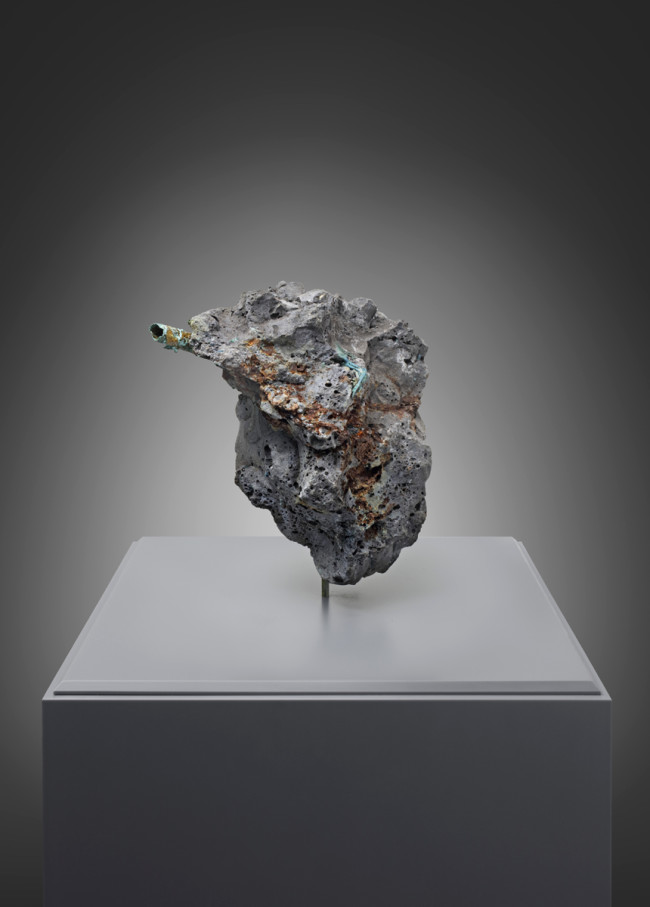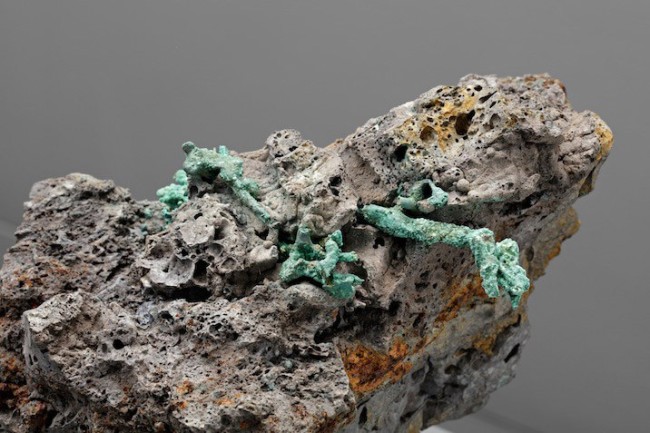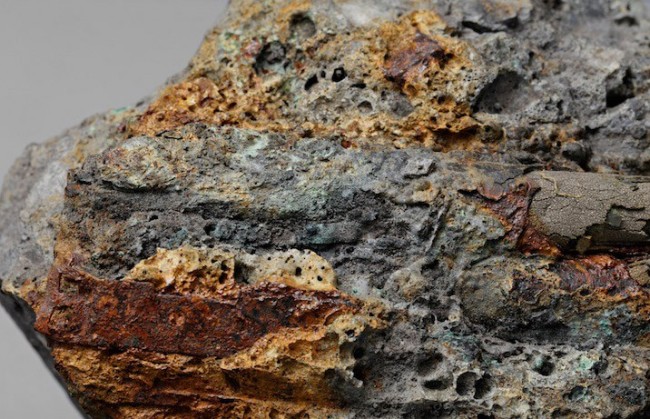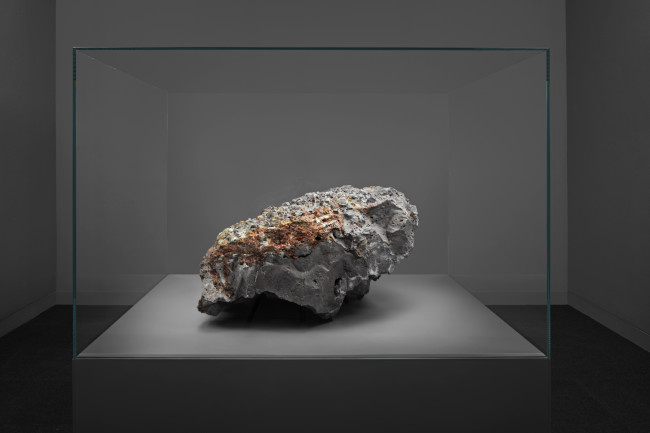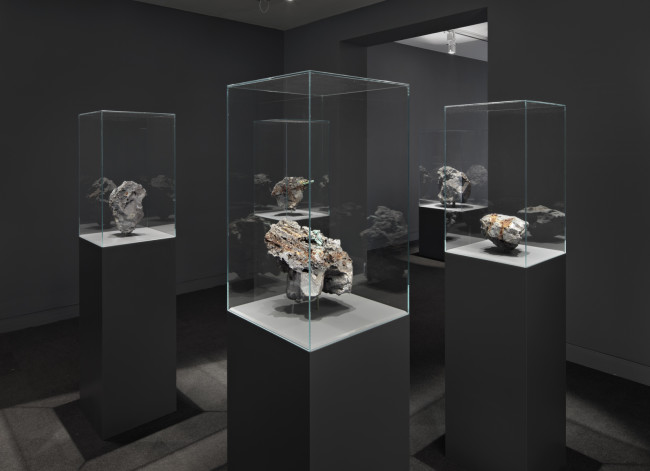29. April - 11. Juni 2016
/ Nows
⟶
NOWs:
Julius von Bismarck: Self-Revolving Torus (Silver), 2016 and Platonic Birth, 2016
For his exhibition Approximately Three Dimensions, Julius von Bismarck created artworks that examine three or more dimensions from all angles. To make a hole, three dimensions are necessary. In the two-dimensions of the iconic thought experiment Flatland, organisms that sustain their existence through a digestive system characterized by two holes, would find themselves split in two along the hole-connecting tube. And if such a punctured, three-dimensional body starts turning itself inside-out through the central hole, it acts out something like the fourth dimension, as imagined from its 3-D perspective.
In the video installation Space Beyond Me he translates two spatial and one temporal dimensions into three spatial ones. In Self-Revolving Torus, the artist uses the analogy of a torus that seems to continuously devour and disgorge itself, to explain the fourth spatial dimension. Finally, in Platonic Birth, a torusresembling opening forces out platonic bodies from the space within. A sense of inevitability characterizes the exhibition, much like the more or less three dimensions that continuously permeate the observer.
Space Beyond Me: Inside the rusty cylindrical room that is constructed using recycled tunnel lining, a film is projected onto the wall, which has been coated with phosphorescent paint. The UV projector at the center of this space mimics the movements performed by the camera, which, at the time, had recorded the film material. It uses a program, developed by the artist, which analyzes found footage to precisely determine the original movement of the camera in terms of three axes: rotation, angle, and zoom. The exact deconstruction of the movements is transferred to the projector, a modified 16mm camera, which carries out these motions as if choreographed. At the end of the projection, all scenes appear on the wall at their correct location. In this manner a time-based medium is transposed onto a spatial medium. The filmed scenario consists of two spatial dimensions and the component of time. The spatial perception of the viewer engages with the landscape glowing on the walls of the projection space to translate this surface back into three spatial dimensions that are independent of time. The film documents a naked man in a desert, who, with difficulty, navigates his way through the dimensions of the monotonous landscape. Any historical and geographical indicators are undecipherable. The viewer cannot tell when and where the film might have been produced, just as she can only wonder at the tunnels that may at one point have been contained by the walls
that surround her now.
Self-Revolving Torus: Five tori, ranging from 40 cm to 1m 40cm in diameter, are shuffling across the floor, animated by their self-revolving surface. Powered by an internal motor, the skin rotates through the central hole, turning the body inside-out. The tori seem alive: yet unknown creatures – furry, plush, clad in leather – that travel the world’s seemingly flat surface by self-absorption and -ejection. Standing amidst these moving bodies, the observer ponders the energetic inward-folding that might be, at this moment, devouring his own body in the fourth dimension.
Platonic Birth: Platonic solids are exhibited below a video that shows their emergence from a torus-resembling opening. Platonic solids have, for thousands of years, expressed the mathematical poetry intrinsic to the four elements and a more ephemeral fifth substance. The video oscillates between three dimensions and infinity, as it describes the birth of the universe or the absurdity of imaging four or more dimensions from within a three-dimensional skull.
The exhibition „Approximately 3 Dimensions“ by Julius von Bismarck at alexander levy will be on from April 29 to June 11, 2016.
Julius von Bismarck: Self-Revolving Torus (Synthetic leather), 2016
Installationview, Julius von Bismarck: Approximately 3 Dimensions at Alexander Levy
NOWs:
Julius von Bismarck: Self-Revolving Torus (Silver), 2016 and Platonic Birth, 2016
For his exhibition Approximately Three Dimensions, Julius von Bismarck created artworks that examine three or more dimensions from all angles. To make a hole, three dimensions are necessary. In the two-dimensions of the iconic thought experiment Flatland, organisms that sustain their existence through a digestive system characterized by two holes, would find themselves split in two along the hole-connecting tube. And if such a punctured, three-dimensional body starts turning itself inside-out through the central hole, it acts out something like the fourth dimension, as imagined from its 3-D perspective.
In the video installation Space Beyond Me he translates two spatial and one temporal dimensions into three spatial ones. In Self-Revolving Torus, the artist uses the analogy of a torus that seems to continuously devour and disgorge itself, to explain the fourth spatial dimension. Finally, in Platonic Birth, a torusresembling opening forces out platonic bodies from the space within. A sense of inevitability characterizes the exhibition, much like the more or less three dimensions that continuously permeate the observer.
Space Beyond Me: Inside the rusty cylindrical room that is constructed using recycled tunnel lining, a film is projected onto the wall, which has been coated with phosphorescent paint. The UV projector at the center of this space mimics the movements performed by the camera, which, at the time, had recorded the film material. It uses a program, developed by the artist, which analyzes found footage to precisely determine the original movement of the camera in terms of three axes: rotation, angle, and zoom. The exact deconstruction of the movements is transferred to the projector, a modified 16mm camera, which carries out these motions as if choreographed. At the end of the projection, all scenes appear on the wall at their correct location. In this manner a time-based medium is transposed onto a spatial medium. The filmed scenario consists of two spatial dimensions and the component of time. The spatial perception of the viewer engages with the landscape glowing on the walls of the projection space to translate this surface back into three spatial dimensions that are independent of time. The film documents a naked man in a desert, who, with difficulty, navigates his way through the dimensions of the monotonous landscape. Any historical and geographical indicators are undecipherable. The viewer cannot tell when and where the film might have been produced, just as she can only wonder at the tunnels that may at one point have been contained by the walls
that surround her now.
Self-Revolving Torus: Five tori, ranging from 40 cm to 1m 40cm in diameter, are shuffling across the floor, animated by their self-revolving surface. Powered by an internal motor, the skin rotates through the central hole, turning the body inside-out. The tori seem alive: yet unknown creatures – furry, plush, clad in leather – that travel the world’s seemingly flat surface by self-absorption and -ejection. Standing amidst these moving bodies, the observer ponders the energetic inward-folding that might be, at this moment, devouring his own body in the fourth dimension.
Platonic Birth: Platonic solids are exhibited below a video that shows their emergence from a torus-resembling opening. Platonic solids have, for thousands of years, expressed the mathematical poetry intrinsic to the four elements and a more ephemeral fifth substance. The video oscillates between three dimensions and infinity, as it describes the birth of the universe or the absurdity of imaging four or more dimensions from within a three-dimensional skull.
The exhibition „Approximately 3 Dimensions“ by Julius von Bismarck at alexander levy will be on from April 29 to June 11, 2016.
Julius von Bismarck: Self-Revolving Torus (Synthetic leather), 2016
Installationview, Julius von Bismarck: Approximately 3 Dimensions at Alexander Levy
